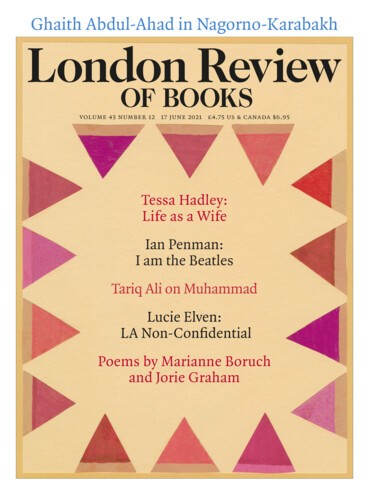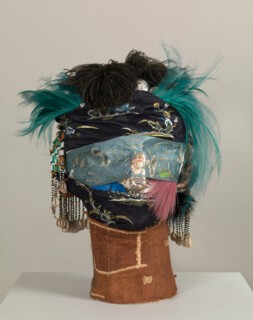The Whitechapel’s ground-floor gallery is full of heads, not all of them with faces. At the entrance to this retrospective – her largest to date, showing until 29 August – sharp-bobbed Eileen Agar, 28 years old, looks out from Self-Portrait (1927) as if pondering her next move. In her autobiography, A Look at My Life, she described this as her ‘first successful work’, though it gives little indication of the direction she was to take only a few years later. Beyond the opening panel, Agar’s heads take on wild new forms. Marine Collage (1939) is composed of four female silhouettes cut from illustrated paper. Three show weird creatures (a long-necked monster baring its teeth, an eel with a fish in its jaws, a flamboyantly tangled octopus) and a solitary Greek statue, its face obscured by an open shell. Elsewhere, jellyfish float towards the seabed in a cut-out profile; abstract shapes converge inside the heads of four horses; line-drawn faces peep out in bemusement from a confluence of spirals and squiggles. In a watercolour from 1935, Agar appears again, palette in hand, shielding her eyes with her palm, her expression confident.
The various gazes converge on a vitrine at the centre of the room containing her most famous work, Angel of Anarchy (1936-40), which gives the exhibition its title. The piece began as a plaster head modelled on her second husband, Joseph Bard, but Agar was disturbed by its resemblance to a death mask and decided to decorate it with some of the ‘fantastic bric-à-brac’ she kept close to hand. She put diamanté gemstones round the nose and mouth, hung curtains of beads to resemble hair and wrapped the whole face tightly in embroidered silk, topped off with ostrich feathers in turquoise and black. A silk scarf is bound around the eyes like a blindfold – maybe this is a modern Tiresias. Agar was interested in transformations and transitions, between earthly and sublime, human and non-human. She was also keenly aware of the gendered double standards that structured classical mythology, as well as her own life, and addressed these ideas in a self-portrait, Ladybird, from 1936. Using white and black paint she doodled lines, stars, disembodied hands and devil horns over a nude photograph of herself, turning it into a ghostly winged monster.
According to Bard, Agar specialised in ‘trying to do something in a way that cannot be done, such as making love standing up in a hammock’. She had an improbable early life. Born in Buenos Aires in 1899, she was heiress to a Scottish windmill fortune. Her family allowed her to train at the Slade only on the condition that a Rolls Royce dropped her off and picked her up again each day. She spent the 1920s coasting round the Mediterranean with Picasso, Ezra Pound, Natalie Barney and Yeats, and was one of the few women included in the International Surrealist Exhibition of 1936 (although she rejected labels, insisting that her work should be seen as the product of her imagination rather than of a historical phenomenon). She started out painting whatever was nearest – ‘an empty milk bottle and a pot of flowers’ – but changed direction after accidentally shattering a mirror: she resolved to ‘exorcise the bad luck by creating a new image of a more liberated and imaginative being’. After the collapse of her brief first marriage to Robin Bartlett (an experience she described as an ‘escape-hatch … from the clutches of my family’), she and Bard lived in Virginia Woolf’s old flat in Fitzroy Square, before moving in 1929 to Paris, where Agar studied with the Cubist painter František Foltýn. Within months she had abandoned figurative painting and was experimenting with altogether new approaches to form and subject, drawing on abstraction and Surrealism. She considered Three Symbols (1928-30) her ‘first attempt at an imaginative approach to painting’. A simplified Ionic column, Notre-Dame and a Gustave Eiffel bridge float, Chagall-like, in a mash-up of classical and modern symbols. Around the same time, she began to develop her theory of ‘womb-magic’, a feminine creative faculty that could serve as a counterweight to the ‘rampant and hysterical militarism’ gaining pace in the 1930s. Yet she never entirely renounced the everyday: she was suspicious of working from dreams and found automatism ‘impracticable’. Her teasing blend of representation and fantasy is the result of a commitment to ‘the interpenetration of reason and unreason’. Technical assurance, in particular her careful attention to geometry and design, augments her curiosity and her delight in the unexpected.
Agar made her first collage shortly after separating from Bartlett. In the course of packing up their shared studio, she came across a skull he’d pinched from an anatomy class at the Slade, and decided to return it to him. His mother opened the package, assumed it was a threat, and sent it back in a fury. Now that it was restored to her, Agar could contemplate the skull’s potential: she painted it gold and covered the forehead in tiny seashells. This was her first encounter with the ‘drama of the found object’, as she later described it, and it suggested new artistic possibilities. Much of her work, whether painting, collage or assemblage, attempts a ‘displacement of the banal by the fertile intervention of chance or coincidence’. Odd choices and uncanny juxtapositions demonstrate her eye for the incongruous: the artfully placed leaf, the splodge of a wax seal, a snakeskin frame. Agar’s work is an invitation to pareidolia; if you linger long enough associations form freely. Look at the mix of shapes inside Untitled (1936). A skull emerges, then a star, a dancing figure behind a windowpane (or is it the bars of a prison?), then a neat strip of small squares that could be a block of flats seen by night; there’s also a row of matchsticks, a feature of another collage from that year, in which they are painted as tiny soldiers. Many of Agar’s works are comprised of a plain background on which is imposed a formal outline – usually a silhouette – which becomes a porthole to other realms. The four trompe l’oeil panels of her Autobiography of an Embryo (1933-34) show an array of ovals, circles and rectangles, inside which appear sinewy bodies, sculpted heads, draped statue-like figures, a brick wall, birds, hands, bullseyes, seahorses and blocks of pure colour. Small cherub-like figures on the border above the panels lend a sense of theatricality, as if these images are the setting for some fantastic, untold story.
The sea offered Agar imaginative and literal material. She loved beachcombing, and her finds regularly ended up glued onto paintings or assembled into talismanic sculptures, such as Marine Object, an ancient, barnacle-encrusted amphora retrieved from a local fisherman, or Fish Basket, a wicker basket (or is it a trap?) filled with shells, its entrance guarded by a cardboard shrimp. She compared the accumulation in her Kensington flat to ‘a sea-wreck cast up by the tide’. At the Whitechapel, an upstairs gallery devoted to photography shows Agar on the beach with Picasso, who is topless and smoking by an upturned boat; Dora Maar in a polka-dot bikini; and Paul Nash, who was her lover for around a decade and shared her enthusiasm for found forms. An entire wall is taken up with pictures Agar took in Ploumanac’h, Brittany, in July 1936. Observing the colossal marine rock formations jutting out against the sky, one like ‘a gigantic head tuned with organ pipes’, another ‘a great buttock ending in a huge thumb’, she immediately bought a camera. In the resulting images, dark shadows heighten the surface textures, revealing patterns produced by centuries of erosion. In 1984, almost fifty years later, Agar used the photographs as inspiration for paintings in hallucinogenic blues and purples (they are hung at the end of the show). Transmuting the photographs into paintings, struck anew by their resemblance to ‘enormous prehistoric monsters sleeping on the turf’, she accentuated the monstrousness of the rocks; despite the softened edges and dreamy palette, their craters are dark and sinister.
Agar often used mythological tropes and figures – Demeter, Aurora, the maenad, the Minotaur – to explore contemporary themes. Her growing concern with the mechanisation of society and the exploitation of nature didn’t take away from the ‘spirit of play’ she thought essential to art and life. If her work sometimes provokes a double-take, spare a thought for those encountering it in the wild. On the second floor at the Whitechapel, a Pathé newsreel shows Agar wearing Ceremonial Hat for Eating Bouillabaisse (1936), which she described as ‘a sort of Arcimboldo headgear for the fashion conscious’. ‘What is it?’ asks the male voiceover. ‘There’s a lobster, a tigerfish, a prawn, seashells, marine flowers, and a starfish.’ ‘Is it something to eat? No! A hat.’ Agar is shown strolling serenely down the street while passersby gawp. The presenter’s exasperation is palpable. ‘That’s the trouble with a woman,’ he concludes, ‘always up to new tricks to bemuse the men.’
Send Letters To:
The Editor
London Review of Books,
28 Little Russell Street
London, WC1A 2HN
letters@lrb.co.uk
Please include name, address, and a telephone number.


